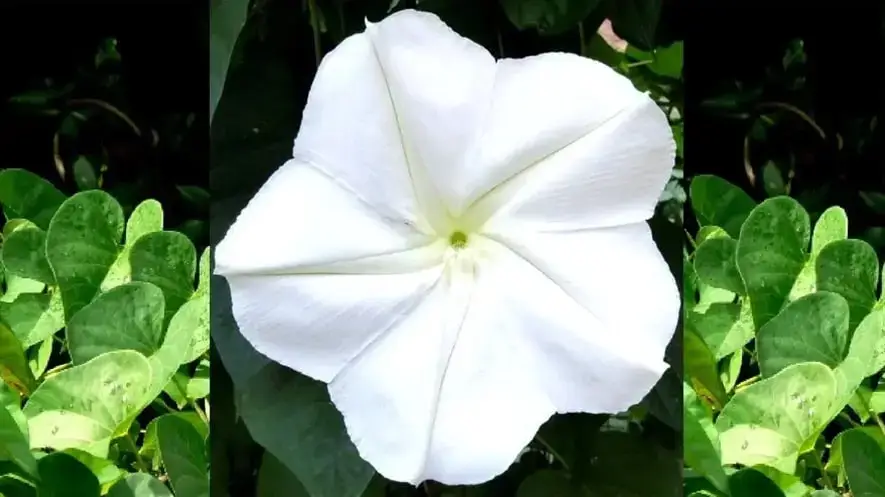
Moon Flower Plant, Moonflower, is a stunning, mystical plant that blooms under the soft light of the moon. With its large, fragrant, white flowers, the Moonflower can transform any garden into an enchanting nighttime retreat. Whether you’re an experienced gardener or just starting, this guide will walk you through everything you need to know about growing and caring for this beautiful plant.
What is a Moon Flower Plant?
The Moon Flower Plant, scientifically known as Ipomoea alba, is a type of night-blooming vine related to the morning glory. Its large, trumpet-shaped flowers open in the evening and release a sweet fragrance that attracts nighttime pollinators like moths. By morning, the flowers close, making the plant a true nocturnal beauty.
How to Grow Moonflowers: A Step-by-Step Guide
Choosing the Right Spot: Moonflowers thrive in full sun to partial shade. Find a spot in your garden that gets at least 6 hours of sunlight during the day. Since Moonflower vines can grow quite tall, make sure there’s a structure nearby like a trellis, fence, or even a pergola for them to climb on.
Preparing the Soil: Moonflower plants prefer well-draining soil. Before planting, work organic compost into the soil to ensure it’s rich and fertile. If you’re planting in pots, use a high-quality potting mix.
Planting Moonflower Seeds: Moonflower seeds have a hard outer shell that benefits from a little pre-planting preparation:
- Scarify the Seeds: Lightly nick the Moonflower seeds with a nail file (cutter) or soak them in water for 24 hours to help them germinate faster.
- Planting Depth: Sow the Moonflower seeds about 1/4 inch deep in the soil.
- Spacing: Space the Moonflower seeds about 6 inches apart to give them room to grow.
Watering: Keep the soil consistently moist but not waterlogged. Water the plants deeply once a week, increasing the frequency during dry spells. Make sure not to overwater, as Moonflowers don’t like soggy roots.
Providing Support: As the Moonflower vines grow, gently guide them towards their support structure. You can use garden ties or soft twine to help train the vines.
Caring for Your Moonflower
Fertilizing: Moonflowers aren’t heavy feeders, but they will benefit from a balanced, slow-release fertilizer applied in the spring. Avoid high-nitrogen fertilizers as they can promote leaf growth at the expense of flowers.
Pruning: Pruning isn’t necessary for Moonflower plants, but you can trim them back if they become too unruly or if you want to shape them. Remove any dead or damaged leaves to keep the plant looking tidy.
Pest Control: Moonflowers are relatively pest-free, but keep an eye out for common garden pests like aphids or caterpillars. If you spot any, treat them with insecticidal soap or a gentle homemade spray made from water and dish soap.
Once your Moon Flower Plant starts blooming, sit back and enjoy the show. The large, luminous flowers are a delight to watch as they unfurl in the evening. You can even plan a moonlit garden party to showcase your nocturnal blooms!
Common Issues of Moon Flower Plant, Moonflower
- No Blooms: If your Moonflower isn’t blooming, it might not be getting enough sunlight. Ensure it gets at least 6 hours of sun per day.
- Yellow Leaves: Yellowing leaves can indicate overwatering. Check your watering schedule and adjust as needed to prevent root rot.
- Slow Growth: Poor soil can slow down growth. Adding compost or a balanced fertilizer can give your plants a nutrient boost.
Benefits of Moon Flower Plant, Moonflower
The Moon Flower Plant, commonly known as Moonflower, is more than just a beautiful addition to your garden. Its benefits extend beyond its enchanting appearance, making it a favorite among gardeners and nature enthusiasts alike. Let’s explore why growing Moonflowers can be a rewarding experience.
Enhancing Garden Beauty: Moonflowers are renowned for their large, luminous white flowers that bloom at night, filling your garden with a mesmerizing fragrance. These flowers not only add aesthetic appeal but also create a serene and magical atmosphere, perfect for evening strolls or outdoor gatherings under the moonlight.
Attracting Nocturnal Pollinators: One of the significant benefits of Moonflowers is their ability to attract nocturnal pollinators like moths. The sweet fragrance and nectar-rich blooms draw these beneficial insects, supporting biodiversity in your garden ecosystem. This natural pollination helps in the reproduction of plants and enhances overall garden health.
Easy to Grow and Low Maintenance: For gardeners of all levels, Moonflowers are a delight to grow. They are relatively low-maintenance, requiring well-draining soil, adequate sunlight, and regular watering. Once established, these vigorous climbers quickly cover trellises, fences, or arbors, providing shade and privacy while beautifying your outdoor space.
Symbolic and Therapeutic Value: Beyond their practical benefits, Moonflowers hold symbolic significance in various cultures, often associated with spirituality, transformation, and lunar energies. Growing them can offer a sense of connection to nature and the cycles of the moon, promoting mindfulness and relaxation.
Suitable for Different Garden Settings: Whether you have a sprawling garden or limited space, Moonflowers can adapt. They thrive in containers, hanging baskets, or directly planted in garden beds, making them versatile for various gardening preferences and environments.
Environmental Benefits: In addition to their beauty, Moonflowers contribute to environmental conservation by attracting pollinators and supporting local biodiversity. By cultivating these plants, you contribute to the ecological balance of your surroundings.
Choosing to grow Moon Flower Plant, Moonflower, offers not only visual delight but also ecological and symbolic benefits. Whether you’re drawn to their ethereal blooms, their role in attracting pollinators, or their ease of cultivation, Moonflowers are a wonderful addition to any garden. Start your own Moonflower garden today and experience the joys of nurturing these nocturnal beauties under the moonlit sky.
Pros and Cons of Moon Flower Plant, Moonflower
Pros
- Nighttime Blooms: Moonflowers bloom at night, creating a magical garden ambiance.
- Fragrant Flowers: The sweet fragrance attracts nighttime pollinators and adds a pleasant scent to your garden.
- Easy to Grow: Moonflower plants are relatively low-maintenance and easy for beginners to cultivate.
- Fast Growth: These vines grow quickly, providing rapid coverage for fences, trellises, and pergolas.
- Pest-Resistant: Moonflowers are generally resistant to pests, reducing the need for pesticides.
- Attracts Wildlife: They attract beneficial pollinators like moths, promoting garden biodiversity.
- Aesthetic Appeal: The large, white flowers add a striking visual element to any garden.
- Versatile Planting Options: Suitable for growing in pots, hanging baskets, or directly in the garden.
- Symbolic Significance: Moonflowers are often associated with beauty, transformation, and nocturnal magic.
- Minimal Pruning: They require little pruning, making them easy to manage.
- Resilient: These plants can adapt to different soil conditions as long as the soil is well-draining.
Cons
- Annual Plant: Moonflowers are annuals in many climates, requiring replanting each year.
- Sensitive to Cold: They are not frost-tolerant and need warm temperatures to thrive.
- Invasive Potential: In some areas, Moonflowers can become invasive if not managed properly.
- Late Bloomer: The plant can take a while to start blooming, sometimes testing the patience of gardeners.
- Hard Seed Coat: The seeds require scarification or soaking before planting to ensure good germination.
- Limited Daytime Appeal: Flowers close during the day, reducing daytime visual appeal.
- Water Sensitivity: Requires consistent moisture but doesn’t tolerate soggy soil, needing careful watering.
- Large Space Needed: As a climbing vine, Moonflowers need ample space and support structures to grow.
- Can Overwhelm Structures: If not pruned, they can quickly take over trellises and other supports.
- Potential Allergens: The strong fragrance may trigger allergies in sensitive individuals.
- Short Bloom Duration: Individual flowers only last one night, requiring continuous blooming for prolonged beauty.
Frequently Asked Questions (FAQ)
| Question | Answer |
|---|---|
| What is a Moon Flower Plant? | The Moon Flower Plant, or Moonflower, is a night-blooming vine with large, fragrant white flowers that open in the evening. |
| How do I plant Moonflower seeds? | Scarify or soak the seeds, then plant them 1/4 inch deep in well-draining soil with ample sunlight. |
| What kind of soil is best for Moonflowers? | Moonflowers prefer well-draining soil enriched with organic compost. |
| How much sunlight do Moonflowers need? | They need at least 6 hours of sunlight per day for optimal growth. |
| Do Moonflowers need a lot of water? | Moonflowers require consistent moisture but should not be overwatered to avoid root rot. |
| Can Moonflowers grow in pots? | Yes, Moonflowers can thrive in pots if given proper support and soil conditions. |
| Are Moonflowers perennial or annual? | Moonflowers are typically grown as annuals in most climates. |
| Do Moonflowers attract pests? | Moonflowers are generally resistant to pests, though occasional monitoring is advised. |
| How do I support Moonflower vines? | Provide a trellis, fence, or pergola for the vines to climb on. |
| When do Moonflowers bloom? | Moonflowers bloom in the evening and remain open through the night. |
| How do I handle Moonflower seeds? | Scarify the seeds by nicking or soaking them in warm water for 24 hours before planting. |




